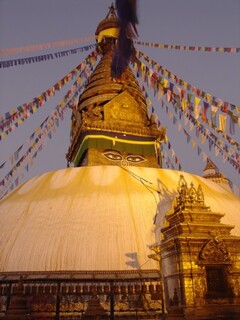Prayer to the Svayambhū Stūpa
༄༅། །བལ་ཡུལ་མཆོད་སྡོང་འཕགས་པ་ཤིང་ཀུན་ལ་གསོལ་འདེབས་བཞུགས།
A Prayer to the Svayambhū Stūpa1 in Nepal
by Jamyang Khyentse Chökyi Lodrö
ཨེ་མ་ཧོ།
emaho
Emaho!
རང་བྱུང་ཆོས་སྐུའི་མཆོད་སྡོང་ཆེན་པོ་ནི། །
rang jung chö küi chö dong chen po ni
This great spontaneously arisen stūpa of the dharmakāya,
རྒྱལ་བ་རྣམས་ཀྱི་ཐུགས་ཀྱིས་བྱིན་བརླབས་ཤིང་། །
gyalwa nam kyi tuk kyi chinlap shing
Infused with the blessings of the buddhas’ wisdom minds,
རྡོ་རྗེའི་ཟོམ་ཞེས་གྲགས་པ་ཆེན་པོ་དེར། །
dorjei zom zhé drakpa chen po der
To this place, renowned as the “Vajra Peak”,2
ངོ་མཚར་བསམ་མི་ཁྱབ་ལ་གསོལ་བ་འདེབས། །
ngo tsar sam mi khyap la solwa dep
So wondrous as to defy the imagination, I pray!
ཤཱནྟ་པུ་རིའི་གྲོང་ཁྱེར་ས་སྤྱོད་ཞིང་། །
shanta puri drong khyer sa chö zhing
In the earthly town of Śāntipur
ཧེ་རུ་ཀ་ཡི་སྤྲུལ་པའི་དཀྱིལ་འཁོར་བཞུགས། །
he ru ka yi trulpé kyilkhor zhuk
Lies the emanated maṇḍala of the Heruka,
འཕགས་པ་ཤིང་ཀུན་གཟུགས་སྐུའི་མཆོད་སྡོང་ཆེ། །
pakpa shing kün zuk küi chö dong ché
The great rūpakāya stūpa of Svayambhū,
གོ་མ་ས་ལ་གནྡྷར་གསོལ་བ་འདེབས། །
go ma sa la gendhar solwa dep
To the Gomasālagandha,3 I pray!
དུས་གསུམ་རྒྱལ་བ་རྣམས་ཀྱིས་ཞབས་བཅག་ཅིང་། །
dü sum gyalwa nam kyi zhap chak ching
The Buddhas of past, present and future all set foot here,
སྔོན་བྱོན་སངས་རྒྱས་རབས་བདུན་རིང་བསྲེལ་གྱི། །
ngön jön sangye rab dün ring sel gyi
And it's filled with the jewel-like relics of the buddhas of the seven ages—
ནོར་བུས་ཕྱུར་བུར་གཏམས་པའི་མཆོད་སྡོང་ཆེ། །
norbü chur bur tampé chö dong ché
To this great stūpa, in devotion,
གུས་པས་ཕྱག་མཆོད་རྟག་ཏུ་གསོལ་བ་འདེབས། །
gü pé chak chö taktu solwa dep
I pay homage and offer constant prayer!
སྡིག་བཤགས་ཡི་རང་ཆོས་འཁོར་བསྐོར་བར་བསྐུལ། །
dik shak yi rang chö khor korwar kül
I confess my harmful actions, rejoice in virtue, request the turning of the Dharma wheel,
བཞུགས་གསོལ་འདེབས་ཤིང་དགེ་ཚོགས་འགྲོ་ལ་བསྔོ། །
zhuk sol dep shing gé tsok dro la ngo
Implore the buddhas to remain, and dedicate my merits to living beings—
སྐུ་གསུམ་གོ་འཕང་དམ་པ་མངོན་བྱེད་ཤོག །
ku sum go pang dampa ngön ché shok
May they all arrive at the sublime attainment of the three kāyas!
རྟེན་མཆོག་འདི་ཡིས་འཛམ་བུའི་གླིང་ཀུན་བདེ། །
ten chok di yi dzam bü ling kün dé
Through the power of this supreme representation, may happiness reign throughout the whole world,
ཀུན་མཁྱེན་ཐུབ་པའི་བསྟན་པ་དར་ཞིང་རྒྱས། །
kün khyen tubpé tenpa dar zhing gyé
May the teachings of the Omniscient Buddha flourish and spread,
བསྟན་ལ་གནོད་པ་མཐའ་དག་ཞི་བ་དང་། །
ten la nöpa tadak zhiwa dang
May all harm to the teachings be pacified,
ཕན་བདེའི་དགེ་མཚན་རྒྱས་པའི་བཀྲ་ཤིས་ཤོག །
pendéi getsen gyepé tashi shok
And may all be auspicious for positive signs of benefit and happiness to spread far and wide!
ཅེས་པའང་ཆོས་ཀྱི་བློ་གྲོས་པས་རྟེན་མཆོག་ཉིད་ཀྱི་དྲུང་དུ་གསོལ་བ་བཏབ་པའོ།། །།
The one called Chökyi Lodrö made this aspiration in the presence of the sacred stūpa itself.
| Translated by Adam Pearcey, 2008, revised 2015 & 2016 (with many thanks to Hubert Decleer for his comments and corrections).
Source:
'Jam dbyangs chos kyi blo gros. "bal yul mchod sdong 'phags pa shing kun gyi gsol 'debs/" in ’Jam dbyangs chos kyi blo gros kyi gsung ’bum. 12 vols. Bir: Khyentse Labrang, 2012. W1KG12986 Vol. 10: 385
Version: 3.1-20241001
- ↑ The Tibetan title refers to the stūpa as Pakpa shingkun ('phags pa shing kun). On this, see Hubert Decleer, “The Tibetan Name of Svayambhu, 'Phags pa shing kun ('Sacred All-Trees'): What Does it Really Mean?” in Light of the Valley: Renewing the Sacred Art and Traditions of Svayambhu, edited by Tsering Palmo Gellek & Padma Dorje Maitland. Cazadero, CA: Dharma Publishing, pp. 241–72.
- ↑ Even though the Tibetan has zam (“bridge”) here, this must be corrected to zom, to give “Vajra Peak” (rdo rje'i zom), one of the four names of Svayambhū, which changed with each yuga/aeon (Hubert Decleer)
- ↑ Although the editor of the Tibetan text has mistakenly written “gan dho” rather than “gan dha” here, this is not speaking of a gandhola, but is a reference to one of the names of Svayambū, according to the Li yul prophecy (Hubert Decleer).
